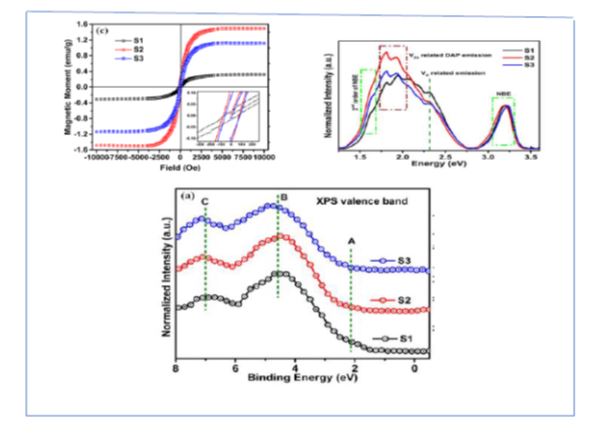Video Article Open Access
Defect Mediated Ferromagnetism in Wide Band Gap Semiconductors: A Material for Spintronics
Santanu Ghosh1,*, Preetam Singh1, Pushp Sen Satyarthi1, Bhawana Joshi1, Pravin Kumar2, Shengiang Zhou3, Pankaj Srivastava1
1Nanostech Laboratory, Department of Physics, Indian Institute of Technology Delhi, New Delhi 110016, India
2Inter University Accelerator Centre, Aruna Asaf Ali Marg, New Delhi 110067, India
3Helmholtz-Zentrum, Dresden-Rossendorf e. V., D-10328, Dresden, Germany
Vid. Proc. Adv. Mater., Volume 3, Article ID 2210364 (2022)
DOI: 10.5185/vpoam.2022.10364
Publication Date (Web): 25 Nov 2023
Copyright © IAAM
Graphical Abstract

Abstract
We have entered in a new age of technology, where the transport of elementary particles will be driven by its spin degree of freedom. New electronics, which is completely based on 'spin' of electron popularly known as 'Spintronics' is a subject of current research. To find the basic materials required for spintronics based devices is a daunting task to materials scientists. In this lecture after introducing briefly the motivation of this new technology, I will highlight the research works carried out in last decade related to wide band gap magnetic semiconductors a basic material for future spintronics. The materials under investigations are zinc oxide (ZnO), gallium nitride (GaN) and Molybdenum di sulphide (MoS2), where room temperature ferromagnetism (RT-FM) has been seen in pure and doped form. Low energy ion irradiation and annealing have been employed as tool to generate defects and trigger and tune RT-FM in these materials. RT-FM has been investigated by SQUID magnetometry. Origin of ferromagnetism was probed by X-ray spectroscopic techniques, X-ray diffraction (XRD), Photoluminescence, electric transport measurement and SQUID. Results will be explained based on magnetic polaron, and d0 ferromagnetism-based models.
Keywords
Magnetic semiconductors; room temperature ferromagnetism; defects, SQUID magnometry, d0 ferromagnetism.
Acknowledgement
Funding from Department of Science and Technology, India and DAAD, Germany.
References
- P. Singh, V Mishra, S Barman, M Balal, S. R. Barman, A. Singh, S. Kumar, R. Ramchandran, P. Srivastava and S. Ghosh, Journal of Alloys and Compounds, 2021, 161663, 889.
- P. Singh, S. Ghosh, V. Mishra, S. Barman, S. Roy Barman, A. Singh, S. Kumar, Kentsch Li Z, and P. Srivastava, Journal of Magnetism and Magnetic Materials, 2021, 167630, 523.
- P. Satyarthi, S. Ghosh, Y. Wang, S. Zhou, D Bürger, I. Skorupa, H. Schmidt, L. Olivi and P. Srivastava; Journal of Alloys and Compounds, 2016, 670 113-22.
- P. Satyarthi, S. Ghosh, Y.Wang , S. Zhou, P. Kumar, D. Kanjilal, L. Olivi, D. Bürger, I. Skorupa, H. Schmidt, and P. Srivastava, Journal of Alloys and Compounds, 2015, 649, 891-8.
- B. Pandey, S. Ghosh, P. Srivastava, P. Kumar, D. Kanjilal, S. Zhou, and H. Schmidt, Journal of Applied Physics, 2010, 107, 023901.
Biography
Santanu Ghosh, Professor, Department of Physics, Indian Institute of Technology Delhi, New Delhi, India is actively involved in the research activities related to magnetic semiconductors, magnetic metal-insulator nanocomposites, nanostructured carbon and silicon rich silicon nitride films. He is also an active researcher in the field of 'Ion-materials interaction. He has about 120 papers published in various international journals, about 17 national and international projects (completed and ongoing), including a prestigious project sanctioned by IAEA, UNO, Vienna. He has authored two books, including one web-based course under NPTEL, and eight book chapters. He has delivered about 50 invited talks in national and international forum and several lectures in a various institute of India and abroad. He was DST-BMBF fellow in the year 2000, DST-DFG fellow in 2006, DAAD-IIT fellow in 2010 and 2013 and delegate for CRP, IAEA, Vienna in 2012, and 2014.
Video Proceedings of Advanced Materials

Upcoming Congress



